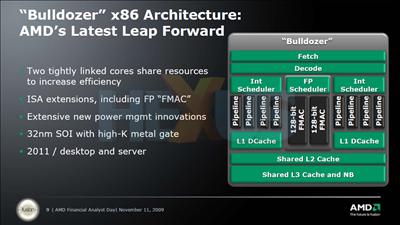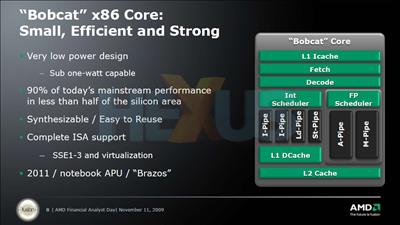AMD's financial analyst day in Sunnyvale, California, yesterday revealed that Llano - a 32nm "Fusion" chip featuring a multi-core CPU with integrated graphics - is likely to be taping out imminently, but it also painted a picture of what the semiconductor manufacturer has in store for beyond 2010.
Having recently examined AMD's roadmaps, we know that the company has plans to revamp both its desktop and netbook architectures in 2011 with the arrival of Bulldozer and Bobcat, respectively.
According to this recent AMD slide, Bulldozer, successor to the K10 architecture, will feature technology not too dissimilar to Intel's own Hyper Threading.
Each Bulldozer core, pictured above, will feature two independent integer execution units - resulting in the operating system seeing two cores. Hoping to out-do Intel, AMD's implementation makes use of independent schedulers and L1 cache, while fetch logic, decode logic, floating-point logic, and L2 and L3 cache remain shared.
Using a four-wide execution unit, up from three on incumbent K10, Bulldozer will be able to match Intel's current Core i7 for processing throughput. As with most PowerPoint slides, it looks promising, and AMD will be able to sandwich multiple Bulldozer cores onto a single die - we expect the first wave of parts to arrive as quad-core solutions.
Trouble is, AMD doesn't expect Bulldozer to arrive until 2011, the year in which the architecture will debut in the enthusiast space as the 32nm Zambezi processor, part of the Scorpius platform. By that time, Intel's Nehalem and Westmere will be ageing, and AMD could find itself going up against Sandy Bridge, or a still-newer design.
In the notebook space, AMD's long-awaited answer to Intel's Atom is still some way off, too. Bobcat, expected to make its appearance as Ontario - a 40nm accelerated processing unit with integrated graphics - also won't appear in ultra-portable systems until 2011.
AMD currently touts a sub one-watt power design, but that ambiguous figure could represent only idle power consumption. What's interesting is that AMD suggests Bobcat will be capable of delivering 90 per cent of today's mainstream performance - presumably Athlon - in less than half the silicon area. Using a synthesisable design, Bobcat should also face an easier transition with each die shrink. Conjecturing somewhat, we could see Bobcat make its way into smartphones when AMD's manufacturing process hits 22nm or less.















